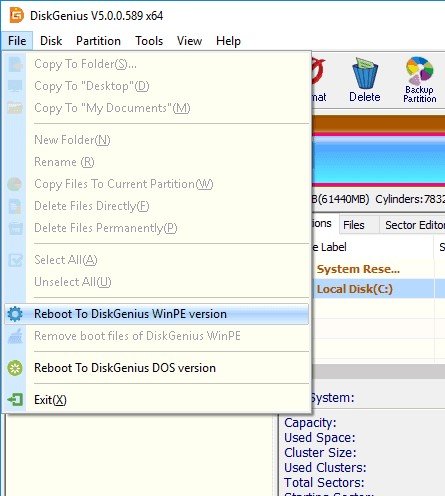- Diskwarrior V5 1 Bootable Image Download
- Diskwarrior V5 1 Bootable Images
- Diskwarrior V5 1 Bootable Image Windows 10
- Diskwarrior V5 1 Bootable Image Creator
Note: The “Startup Disk” of macOS Catalina (10.15), macOS Mojave (10.14), and macOS 10.13 High Sierra with SSDs (Solid State Drives) cannot be rebuilt with DiskWarrior as they are automatically pre-loaded with Apple File System (APFS).
Herospeed Technology is a high-tech company specialized in software development, software customization and software implementation. It owns a group of long-term professionals who are engaged in software development and software customization. PowerISO 3.1 (May 20, 2006) +) Can open audio/video cd image file.) Fixed bug of making bootable image file.) Fixed bug of context menu handler.) Some minor bug fixes. PowerISO 3.0 (Mar 18, 2006) +) Burn image file through microsoft cdburn/dvdburn utility. +) Support up to 8 virtual drives. +) Can assign virtual drive's letter manually.
If you have an earlier version of DiskWarrior, learn about the new features of DiskWarrior 5 and how to upgrade by clicking here.
Please note that to install DiskWarrior 5 onto your start up disk, your Mac must start up in Mac OS X 10.5.8 Leopard through macOS 10.15 Catalina. Please read the system requirements for DiskWarrior 5.
Click herefor important DiskWarrior 4 compatibility news and support.
Click here for important DiskWarrior 3 compatibility news and support.
Click here for important DiskWarrior 2 compatibility news and support.
DiskWarrior now ships on a flash drive instead of DVD. If you plan to rebuild the directory of your startup disk, you need to start up from another disk capable of starting up in Mac OS X 10.5.8 Leopard through macOS 10.15 Catalina, such as the DiskWarrior Recovery flash drive or your Mac's OS X Recovery (the Recovery HD). OS X Recovery is available in OS X 10.7 Lion and later.
Whether started from the DiskWarrior Recovery flash drive, OS X Recovery or another disk, DiskWarrior can run from the flash drive to eliminate all damage to any HFS (Mac OS Standard) and HFS Plus (Mac OS Extended) disk directories, including your normal startup disk.
Click here for step-by-step instructions on starting up from the DiskWarrior Recovery flash drive or OS X Recovery.
The DiskWarrior Recovery flash drive ships with the ability to start up any 64-Bit Intel Mac that currently starts up in Mac OS X 10.4 Tiger, 10.5 Leopard or 10.6 Snow Leopard. If you have a newer Intel Mac, you can use the included DiskWarrior Recovery Maker to update the DiskWarrior Recovery flash drive to start up your newer Mac.
Quick Links:
Mailing List

Starting up from the DiskWarrior USB Flash Drive
1) Insert the DiskWarrior Recovery flash drive directly into a USB port on your Mac.
Do not use a USB port on a hub, external monitor or keyboard. Note: Some USB-C adapters are not suited for startup from data storage devices.
Diskwarrior V5 1 Bootable Image Download
2) Turn on or restart your Mac and immediately press and hold down the Option (alt) key.
After a few seconds, the Startup Manager should appear as shown below. If you see the Apple logo, it’s possible that you didn’t hold Option early enough. Restart and try again.
Diskwarrior V5 1 Bootable Images
A green DiskWarrior Recovery disk icon indicates that the DiskWarrior flash drive contains the DiskWarrior Recovery as it shipped from Alsoft. This disk can boot any 64-Bit Intel Mac that currently starts up in Mac OS X 10.4 (Tiger), 10.5 (Leopard) or 10.6 (Snow Leopard).
If you have a newer Mac that currently starts up in OS X 10.7 (Lion) or later, you will need to update the DiskWarrior flash drive with the included DiskWarrior Recovery Maker. A DiskWarrior Recovery flash drive updated with DiskWarrior Recovery Maker will have a blue disk icon as shown below. Alternatively, you can start up from your Mac's built-in macOS Recovery.
3) Use the left and right arrow keys on the keyboard to select the DiskWarrior Recovery disk and then press the Return key.
Diskwarrior V5 1 Bootable Image Windows 10
If the icon of the DiskWarrior Recovery disk is green then DiskWarrior will launch automatically after the Mac is started up. If the icon of the DiskWarrior Recovery disk is blue then you will be presented with a window from which you will double-click DiskWarrior to launch it.
4) Once DiskWarrior opens you must agree to the software license and then you will see the window below.

Diskwarrior V5 1 Bootable Image Creator
Open the DiskWarrior manual from the Help menu for further instructions on repairing and recovering.
5) If the disk you want to repair is encrypted with FileVault 2, you'll need to unlock the disk.
When a disk is encrypted, the Mount/Unmount tool changes to an Unlock tool. Select the encrypted disk in the pop-up menu and click the Unlock tool. You'll be prompted to enter the password to unlock the disk. You'll need to update the original DiskWarrior Flash drive with DiskWarrior Recovery Maker to add support for FileVault 2.
Note: The “Startup Disk” of macOS Catalina (10.15), macOS Mojave (10.14), and macOS 10.13 High Sierra with SSDs (Solid State Drives) cannot be rebuilt with DiskWarrior as they are automatically pre-loaded with Apple File System (APFS).